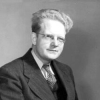Northrop Frye

Northrop Frye
Herman Northrop Frye, CC FRSCwas a Canadian literary critic and literary theorist, considered one of the most influential of the 20th century...
NationalityCanadian
ProfessionPhilosopher
Date of Birth14 July 1912
CitySherbrooke, Canada
CountryCanada
art giving imagination
No matter how much experience we may gather in life, we can never in life get the dimension of experience that the imagination gives us. Only the arts and sciences can do that, and of these, only literature gives us the whole sweep and range of human imagination as it sees itself
art people use
Those who are concerned with the arts are often asked questions, not always sympathetic ones, about the use or value of what they are doing. It is probably impossible to answer such questions directly, or at any rate to answer the people who ask them.
art memories trying
A public that tries to do without criticism, and asserts that it knows what it wants or likes, brutalizes the arts and loses its cultural memory. Art for art's sake is a retreat from criticism which ends in an impoverishment of civilized life itself.
art what-if criticism
What if criticism is a science as well as an art? Not a pure or exact science, of course, but these phrases belong to a nineteenth-century cosmology which is no longer with us.
art moving science
Science begins with the world we have to live in, accepting its data and trying to explain its laws. From there, it moves toward the imagination: it becomes a mental construct, a model of a possible way of interpreting experience. The further it goes in this direction, the more it tends to speak the language of mathematics, which is really one of the languages of the imagination, along with literature and music. Art, on the other hand, begins with the world we construct, not with the world we see. It starts with the imagination, and then works toward ordinary experience.
art tolerance use
Literature encourages tolerance-bigots and fanatics seldom have any use for the arts, because they're so preoccupied with their beliefs and actions that they can't see them also as possibilities.
art nature models
Nature is inside art as its content, not outside as its model.
art poetry literature
In literature, questions of fact or truth are subordinated to the primary literary aims of producing a structure of words for its own sake, and the sign-values of symbols are subordinated to their importance as a structure of interconnected motifs.
art law elements
In our day the conventional element in literature is elaborately disguised by a law of copyright pretending that every work of art is an invention distinctive enough to be patented.
art criticism body
Physics is an organized body of knowledge about nature, and a student of it says that he is learning physics, not nature. Art, like nature, has to be distinguished from the systematic study of it, which is criticism.
art growing-up people
Popular art is normally decried as vulgar by the cultivated people of its time; then it loses favor with its original audience as a new generation grows up; then it begins to merge into the softer lighting of
art law hallucinations
There is a curious law of art...that even the attempt to reproduce the act of seeing, when carried out with sufficient energy, tends to lose its realism and take on the unnatural glittering intensity of hallucination.
art independent emotional
The fact that creative powers come from an area of the mind that seems to be independent of the conscious will, and often emerge with a good deal of emotional disturbance in their wake, provides the chief analogy between prophecy and the arts...Some people pursue wholeness and integration, others get smashed up, and fragments are rescued from the smash of an intensity that the wholeness and integration people do not reach.
philosophy literature mythology
The disinterested imaginative core of mythology is what develops into literature, science, philosophy. Religion is applied mythology.